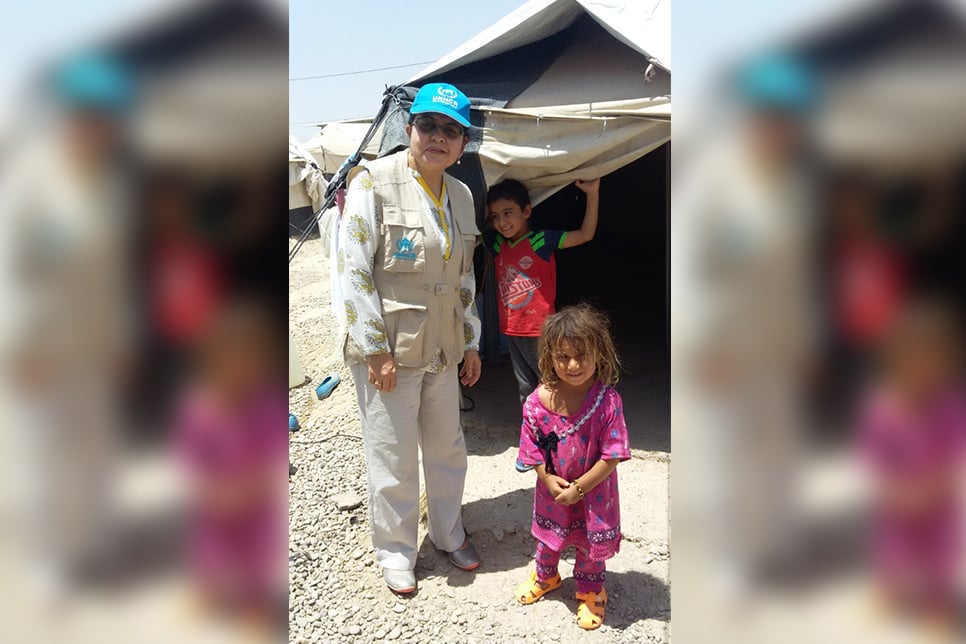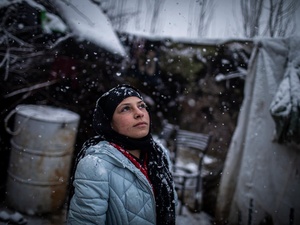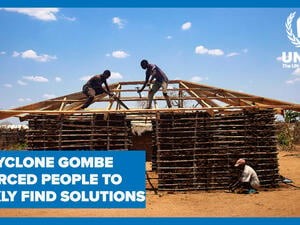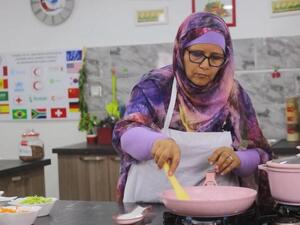Support for internally displaced people needs to be 'urgently stepped up'

Support for internally displaced people needs to be 'urgently stepped up'
Millions of people are forced to flee their homes each year because of conflict or violence. While some cross borders to find safety, many seek refuge within their home countries, often in camps or informal settlements. They share many of the same challenges and vulnerabilities as refugees, including to the risks posed by COVID-19.
Sumbul Rizvi is UNHCR’s Principal Advisor on Internal Displacement, a role she took up in May 2019. Previously, she coordinated the UN’s Rohingya refugee response in Bangladesh. Prior to joining the UN over two decades ago, she practiced law in New Delhi, India.
She spoke with Matthew Mpoke Bigg from UNHCR’s global communications service about why the Guiding Principles on Internal Displacement remain so important, as well as how the COVID-19 pandemic puts IDPs at greater risk.
What factors make some people flee within their own country while others cross borders as refugees?
When confronted with conflict and violence, the vast majority of people flee within their own country. Sometimes a different part of a country is perceived to be safer. Often people seek safety where they have family or community support. Some people lack the financial means, ID documents or a passport that would allow them to travel across an international border. Many consider it easier to earn a living in their own country, while some consider flight to be short term, thus staying in-country is viewed as making return home easier. Flight across international borders is more common when conflict takes place close to a frontier.
What particular challenges do people face when they are internally displaced?
Forced displacement provides a level of safety, away from the immediate conflict, but also brings enormous challenges. These include violence, exploitation or abuse from host communities or from governments, military or armed groups; absence of basic shelter; restrictions on freedom of movement; seizure of documents; limited access to public services and social protections; and loss of income. These risks can prompt resorting to harmful coping mechanisms including child labour, early or forced marriage. Poor nutrition, family separation or strains on family structures are also common. In addition, families from rural areas often struggle to adapt to life in cities where they lack social safety nets. They may be unable to return home because of continued violence or even because their homes have been destroyed.

UNHCR's Principal Advisor on Internal Displacement, Sumbul Rizvi, at a camp for internally displaced people in Salahedin, Iraq, in 2017.
Why do they often need protection and assistance?
Local authorities attempt to provide protection and assistance to people who have been forcibly displaced, but there are situations where governments may not be willing or able to meet their basic needs for food, shelter, legal assistance, education and livelihoods. IDPs may also fear being the target of violence, exploitation or discrimination because of their political affiliation, ethnicity or religion. Women and children can be especially vulnerable to sexual exploitation and abuse and may need additional protection and assistance, including sometimes from their own communities.
Globally, more than 41 million people are displaced inside their own countries. Where are they concentrated, and what sort of conditions do they live in?
People are internally displaced in more than 30 countries. UNHCR supports responses to this displacement in all regions of the world including Afghanistan, Burkina Faso, Central African Republic, Colombia, Democratic Republic of the Congo, Ethiopia, Iraq, Myanmar, Niger, Somalia, South Sudan, Sudan, Syria, Ukraine, Yemen and others.
IDPs live in both urban and rural areas. Sometimes they’re in camps set up by a government or by humanitarian organizations, but they also live in informal sites, which could be a slum or an abandoned or unfinished building. Some live in rented accommodation in cities. Living conditions are often overcrowded, with limited access to water, sanitation and other basic services. This can expose IDPs to a variety of risks such as exposure to infectious diseases, sexual violence and forced eviction.
What difficulties are internally displaced people, or IDPs, facing now because of the threat of coronavirus, and what can be done to help?
The vast majority of IDPs are in developing countries with extremely fragile health systems that could be rapidly overwhelmed if the virus gains a foothold. In addition, many IDPs live in camps or informal sites where overcrowding, poor nutrition, and inadequate provision of water, sanitation and hygiene present enormous challenges for prevention. In urban areas, many are becoming destitute as casual labour and other income opportunities vanish overnight. Interruptions or reductions in the provision of humanitarian or government assistance will make IDPs even more vulnerable both to the virus and other risks.
It’s vital that international support to national governments is urgently stepped up to meet the massive needs. This must include funding for measures to prevent the spread of the virus and to promote the inclusion of IDPs in national preparedness and responses efforts. UNHCR is working with governments, sister UN agencies and NGOs to implement various actions, including communicating with IDPs in camps and informal sites about hygiene and physical distancing. We’re also adapting our programmes so they can be delivered safely; providing emergency cash to the most vulnerable and supporting the upgrading of health facilities.
What are the Guiding Principles on Internal Displacement, and how were they established?
The Guiding Principles on Internal Displacement, adopted 22 years ago tomorrow (17 April), were the first international standards developed for internally displaced people. They set out their rights and governments’ obligations towards them and are widely recognized as the key international framework for responding to internal displacement. The Guiding Principles are a set of 30 standards – based on international human rights and humanitarian law – that outline the rights of IDPs, and how they should be protected and assisted during displacement up until a lasting solution can be found for them.
The need for such standards became evident in the 1990s when the number of people uprooted within their own countries by violence, armed conflict and human rights abuses increased dramatically. With no existing international legal framework for their protection, M. Francis Deng, who was the Representative of the UN Secretary General on IDPs, presented the Guiding Principles to the UN Commission on Human Rights to address the gap. Since their adoption in 1998, they have been widely used by countries, UN agencies and NGOs as the basis for IDP protection. The Guiding Principles remain extremely relevant today. As part of a global initiative called the GP20, UNHCR is supporting States to incorporate the Guiding Principles into their national legislations.
What role does UNHCR play in securing IDPs’ rights and protection and what are the challenges we face?
UNHCR supports authorities in assisting and protecting IDPs by providing technical expertise and undertaking practical interventions through shelter, camp management and protection activities. We also mobilize and coordinate the efforts of NGOs and other UN agencies to make sure gaps are addressed and that there is no duplication of support. Such assistance can be lifesaving and needs to be delivered quickly. Central to UNHCR’s work is ensuring IDPs’ rights are protected and that the risks they face are minimized. The challenges we continue to face relate to uneven legal protections for IDPs and persistent insecurity that impedes humanitarian access, public services and basic livelihood opportunities.
UNHCR recently launched an IDP initiative. Can you tell us a bit more about this?
The IDP initiative steps up UNHCR’s engagement in internal displacement situations through the course of this year and 2021. It focuses on nine countries: Ethiopia, South Sudan, Sudan, Burkina Faso, Democratic Republic of the Congo, Iraq, Afghanistan, Ukraine and Colombia. The aims are to generate examples of good practices; to give greater visibility to the impact of internal displacement on those affected; to secure more resources for IDP responses and to strengthen our support to operations in these nine countries.









